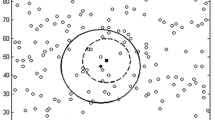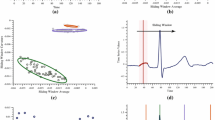Abstract
Motivated by earlier work on adaptive event forecasting, this paper proposes an iterative event signature extraction method for wireless sensor networks, and a probabilistic approach to model non i.i.d. (independent and identically distributed) aperiodic traffic. The model is validated on well described (collection included) real world measurements of various types, and it is then used to demonstrate the effectiveness of the proposed signature extraction method to support reliable event forecasting.
Our scheme can continuously keep the event signature database low on artifacts, dynamically estimate the number of sequences and extract the signatures from noisy, overlapped events.
The proposed solution is inspired by unsupervised competitive Hebbian learning used in self-organizing Kohonen maps. We evaluate the proposed solution analytically, but also empirically, by means of simulations.

















Similar content being viewed by others
References
Chen, S. M., & Chen, C. D. (2011). Taiex forecasting based on fuzzy time series and fuzzy variation groups. IEEE Transactions on Fuzzy Systems, 19(1), 1–12.
Chu, Y. J., & Chen, X. W. (2011). An improved cellular automaton model for two-lane traffic based on anticipation effects, information interaction and sensitive driving. In 2nd international conference on Artificial intelligence, management science and electronic commerce (AIMSEC 2011) (pp. 2783–2786). doi:10.1109/AIMSEC.2011.6010695.
Dargie, W., Chao, X., & Denko, M. (2010). Modelling the energy cost of a fully operational wireless sensor network. Telecommunication Systems, 44, 3–15.
Davies, V. (2000). Evaluating mobility models within an ad hoc network. MS thesis. Colorado School of Mines, Colorado.
Gawron, C. (1998). An iterative algorithm to determine the dynamic user equilibrium in a traffic simulation model. International Journal of Modern Physics C, 3, 393–407.
Khan, D., Navet, N., Bavoux, B., & Migge, J. (2009). Aperiodic traffic in response time analyses with adjustable safety level. In IEEE conference on Emerging technologies factory automation (ETFA 2009). (pp. 1–9). doi:10.1109/ETFA.2009.5347149.
Kuhn, H. W. (1956). Variants of the Hungarian method for assignment problems. Naval Research Logistics Quarterly, 3, 253–258.
Li, S., Lin, Y., Son, S. H., Stankovic, J. A., & Wei, Y. (2004). Event detection services using data service middleware in distributed sensor networks. Telecommunication Systems, 26, 351–368.
Lighthill, M., & Whitham, G. (1955). A theory of traffic flow on long crowded roads. In On kinematic waves II (pp. 317–345).
Liu, J., Liu, J., Reich, J., Cheung, P., & Zhao, F. (2004). Distributed group management in sensor networks: algorithms and applications to localization and tracking. Telecommunication Systems, 26, 235–251.
Natalizio, E., & Loscrí, V. (2011). Controlled mobility in mobile sensor networks: advantages, issues and challenges. Telecommunication Systems, 52(4), 2411–2418.
Öllös, G., & Vida, R. (2011). Adaptive event forecasting in wireless sensor networks. In IEEE vehicular technology conference (IEEE VTC 2011), Budapest, Hungary.
Öllös, G., & Vida, R. (2012). Signature extraction for event forecasting in wireless sensor networks. In: Network strategy and planning symposium (NETWORKS’12), Rome, Italy, 15–18 October 2012.
Sheu, J. P., Hu, W. K., & Lin, J. C. (2008). Ratio-based time synchronization protocol in wireless sensor networks. Telecommunication Systems, 39(1), 25–35.
Chakhchoukh, Y., Bondon, P., Milli, M. (2009). Robust short-term load forecasting using projection statistics. In 3rd IEEE international workshop on computational advances in multi-sensor adaptive processing (CAMSAP 2009) (pp. 45–48).
Yang, H., & Sikdar, B. (2003). A protocol for tracking mobile targets using sensor networks. In Proceedings of the first IEEE international workshop on sensor network protocols and applications (pp. 71–81).
Acknowledgements
The work described in this paper has been (partially) supported by HSNLab, Budapest University of Technology and Economics, http://www.hsnlab.hu.
Author information
Authors and Affiliations
Corresponding author
Rights and permissions
About this article
Cite this article
Öllös, G., Vida, R. Event signature extraction and traffic modeling in WSNs. Telecommun Syst 55, 513–523 (2014). https://doi.org/10.1007/s11235-013-9806-y
Published:
Issue Date:
DOI: https://doi.org/10.1007/s11235-013-9806-y




